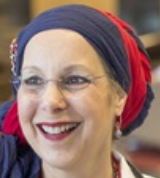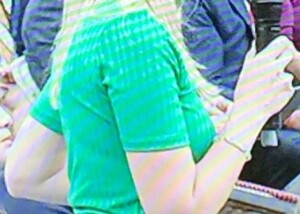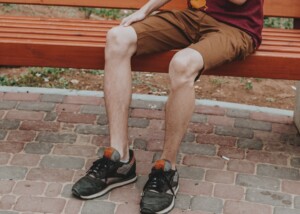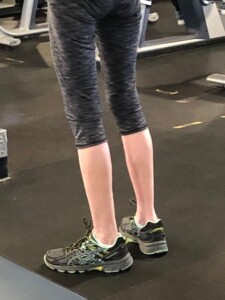
Ever wonder why some elderly women are frightfully thin, when old age is supposed to slow metabolism and make fat gain easier?
Is there some magic reversal of this process?
If a woman has not been strength training, then by the time she’s 30, she begins losing muscle mass.
With that loss of muscle mass comes an increase in weight—in the form of fat.
This is why, as women (and men) get older, the general rule is that they gain weight.
It’s not that suddenly, at age 30, their appetite increases and keeps swelling as each birthday passes.
Rather, it’s the muscle loss that causes fat gain, because muscle is the body’s most metabolically active tissue, burning more calories per hour — just for sustenance — than any other tissue.
So if you lose muscle, your resting metabolism slows down…and you put on unwanted fat pounds.
Why are so many elderly women too thin?
If a woman never takes up strength training, she will lose about five pounds of muscle per decade beginning at around age 30.
She may still be able to fit into her size 8 wedding dress on her 60th birthday, but her body composition will be much different.
There will be a higher fat to muscle ratio, and she’ll look softer and flabbier though still a size 8.
But for most formerly size 8 or 6 women, they will now be a 10, 12 or even 14 or 16, by age 60—thanks to a stunted resting metabolic rate due to lost muscle mass.
So why do we see so many sickly-skinny elderly women?
They not only lack muscle mass, but where the devil is the fat that they were supposed to have gained since age 30?
“As we age, one thing that happens to our bodies is the loss of subcutaneous fat,” says Susan L. Besser, MD, with Mercy Medical Center, Baltimore; Diplomate, American Board of Obesity Medicine and board certified by the American Board of Family Medicine.
“Without that connective tissue the skin thins — tears more easily and wrinkles more — all giving a thinner appearance.
“Additionally, because the elderly as a rule are less active, they tend to lose muscle mass, again increasing the thin appearance.
“This also increases frailty, they become weaker, with poorer balance, which causes them to move less, so more muscle loss and the cycle continues.
“Since activity decreases, appetite decreases. Also, digestion slows down — so less hunger.”
Scary Skinny Senior Lady
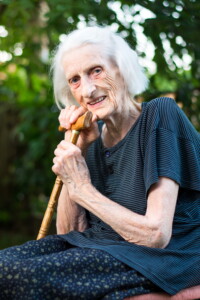
Shutterstock/Creative Family
When you see a scary skinny old lady, she has very little muscle mass—much of it has withered away in her sedentary life.
This should cause a gain in body fat, right? Why isn’t she plump? Some elderly women ARE plump; some are even obese.
In the case of that scary skinny elderly woman, she hardly eats. It’s that simple.
She has lost her appetite as she ventures deeper into the golden years.
The loss of appetite may be related to a medical condition (particularly dementia, points out Dr. Besser), or, it could be nature’s way of paring back as her body’s energy needs decline.
The bones are frail, muscles and joints weak and stiff—there’s not much need for generous portions of food.
So to adjust to this, the appetite declines along with everything else.
You won’t be going out on a limb by assuming that the two elderly women in this article’s images eat like birds.
My elderly mother used to weigh 145. She’s now 120, and I’m trying so hard to get her up to 125.
She’s not as thin as the women featured here…and I’m doing everything possible to keep her above 119.
She’s had some illnesses and medical situations over the years, and every single time, her weight gets into the mid one-teens.
It’s crucial she have a reserve by getting up to 125, so that if she gets pneumonia again, she’ll drop to 120 instead of 115.
Her appetite isn’t what ut used to be. She eats much less these days.
Though she can still fit into her wedding dress, her body composition is drastically different.
As is the case of many elderly women, much of her muscle mass is gone, and most of her body fat is concentrated in her midsection. Her arms and legs have a too-thin appearance.
Ironically, she reports that many of the elderly women at her bridge clubs are quite overweight—and that they eat giant portions of food. “They go at it like vultures,” she says.
An elderly woman who is scary thin has not been consistently and passionately strength training throughout the years, nor does she have a so-called healthy appetite.
Bones have shrunk.
Muscles have whittled away.
Their body’s energy needs are very low.
Their appetite has taken a dive.
The result is a skin-and-bones thin body in these elderly women.
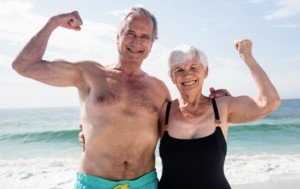
Swim, lift weights, hike hard, hit the yoga mat — muscle is more precious than gold. Credit: Shutterstock/wavebreakmedia
When you see a painfully skinny senior age woman, there IS a very slight chance—very slight—that she has been struggling with anorexia nervosa for decades.
However, anorexia nervosa severely depletes one’s body of health and fitness, and hence, few women with untreated anorexia nervosa make it into elderly age.

